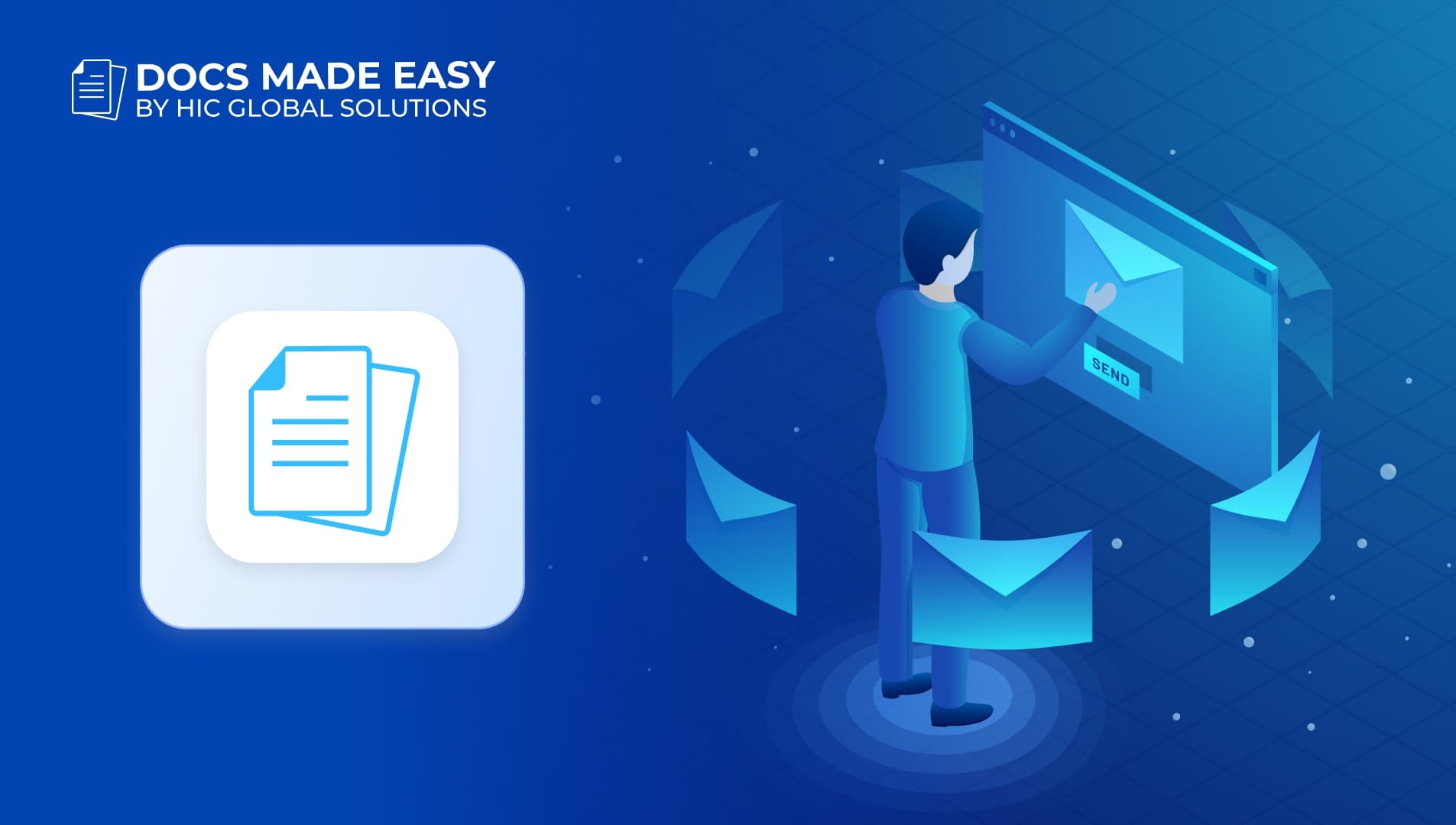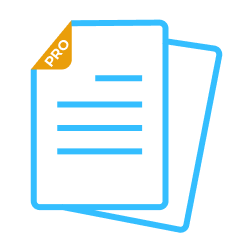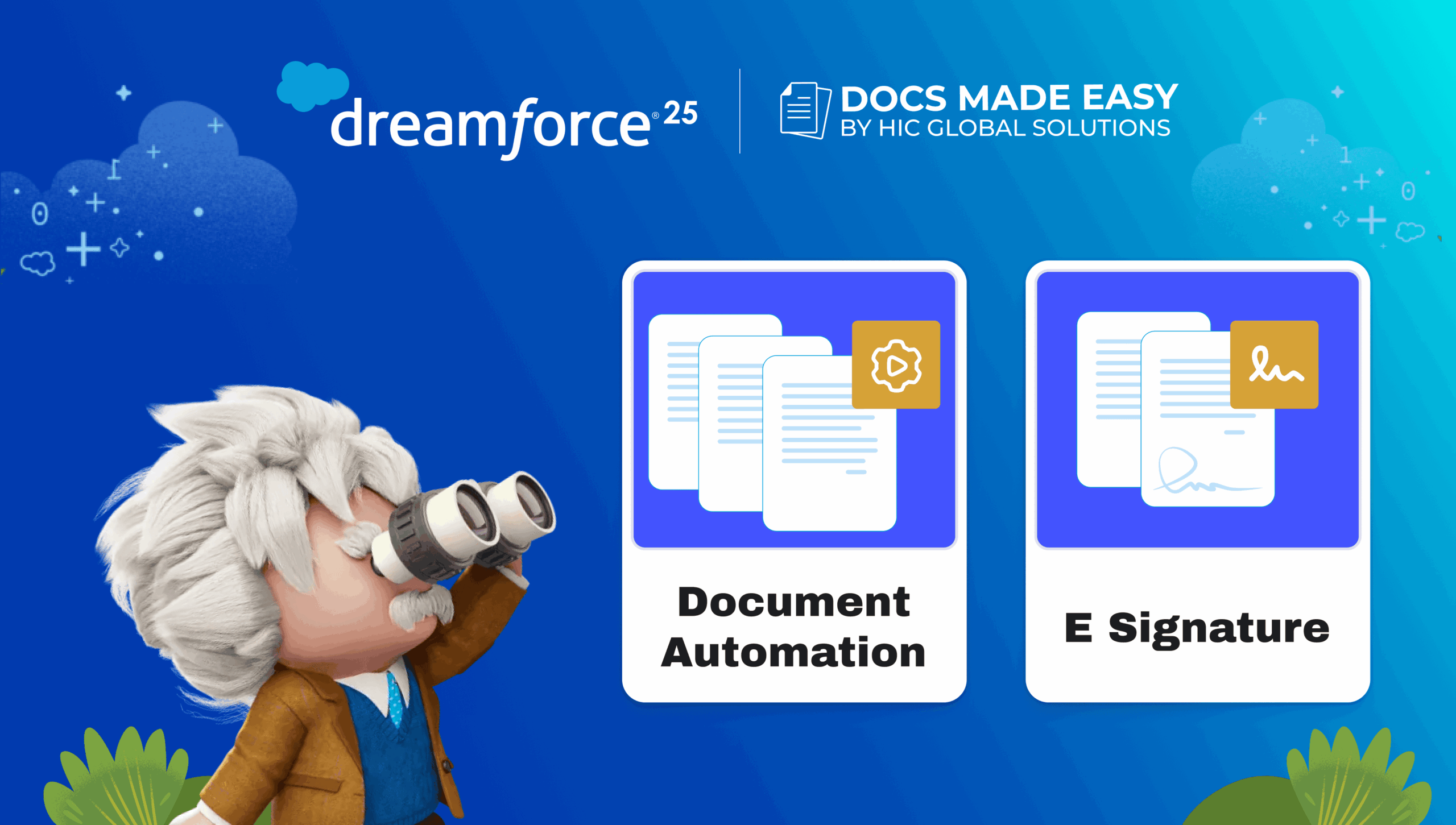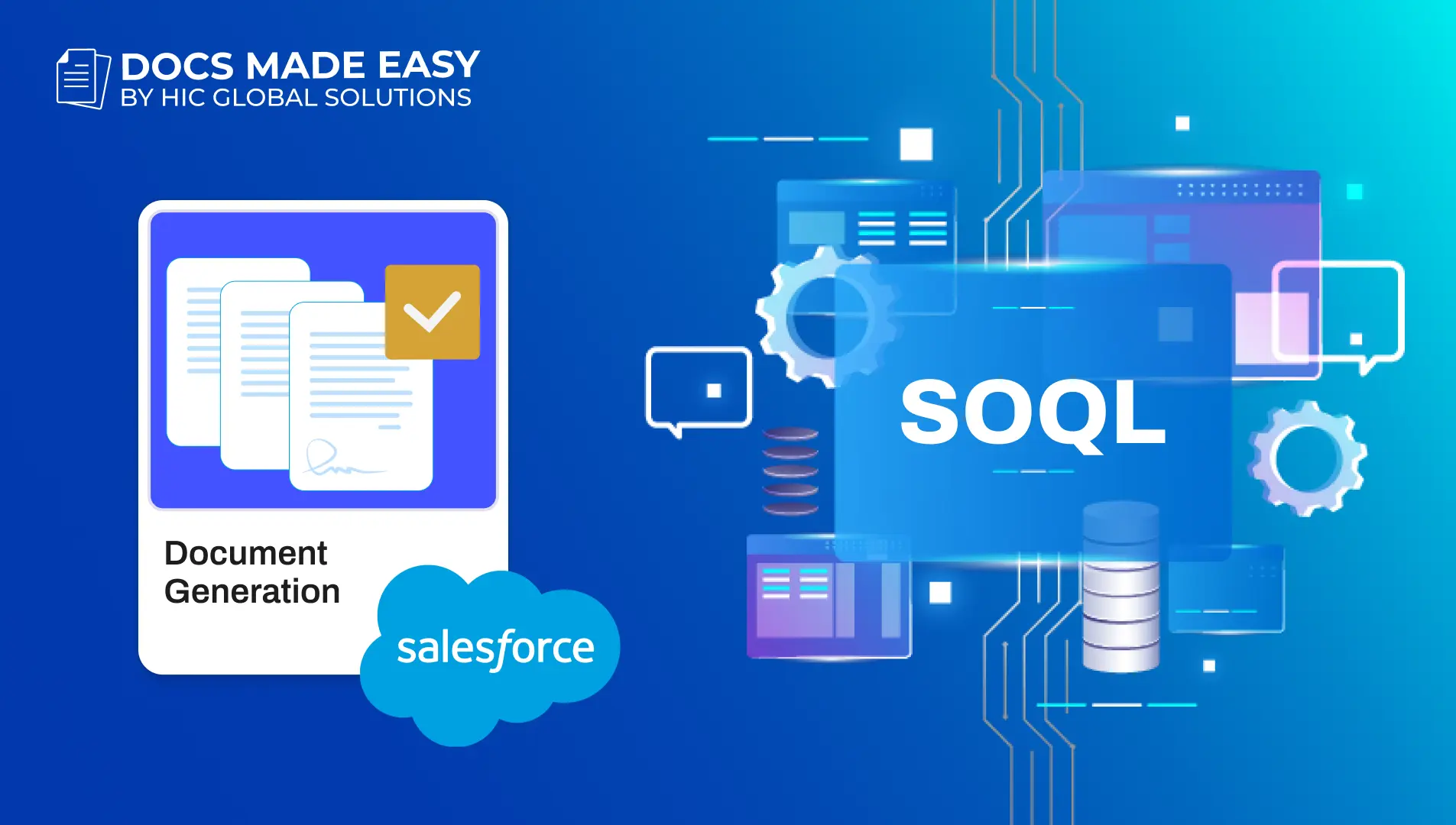In the bustling corridors of Dreamforce 2025, there’s a clear buzz. It’s not just about AI copilots or Salesforce Genie this time -the spotlight is unexpectedly turning toward something more practical, yet transformative: Document Automation and E-Signature solutions.
For Salesforce admins, developers, consultants, and business leaders, this year’s event isn’t just about exploring shiny new features; it’s about solving real operational challenges that have held teams back for years. From manual document generation to sluggish contract approvals, organizations have long struggled to connect the dots between their Salesforce data and the documents that drive revenue.
Dreamforce 2025 is setting the stage for a future where contracts to closures happen seamlessly – and automation is the silent force behind it.
Dreamforce 2025: The Stage for Practical Innovation
Every September, Dreamforce brings together tens of thousands of Trailblazers from around the globe. It’s part learning festival, part innovation showcase, part Salesforce family reunion. But beyond the big product announcements and celebrity keynotes, Dreamforce 2025 feels different.
The conversations in breakout sessions and the demos on the expo floor reveal a subtle shift: companies are doubling down on process optimization. Instead of just adding more tools, they’re streamlining the ones that matter most — especially document workflows.
In a world where buyers expect instant quotes, flawless contracts, and digital signatures without delays, Document Automation and E-Signature solutions are no longer sidekicks. They’re center stage.
We’ve automated lead scoring, forecasting, and marketing – but contract generation remained painfully manual. Dreamforce 2025 is finally bringing that change to the forefront,
Salesforce Consultant
The Manual Bottleneck: When Documents Slow Down Deals
Picture this: A sales rep closes a call with a warm lead. The client’s ready to sign. But instead of sending the contract in minutes, the rep spends hours generating a proposal, copy-pasting data from Salesforce into Word, formatting tables, hunting down legal clauses, and sending it for internal approval.
Then the document sits in someone’s inbox. Days pass. Momentum fades. The deal loses urgency.
Sound familiar?
For many Salesforce users – from admins building flows to consultants designing sales processes – manual document workflows are the hidden bottleneck. They eat up time, increase error rates, and create friction in the customer journey.
For decision-makers, the problem is even bigger: delayed revenue recognition, compliance risks, and inconsistent branding across critical business documents.
And here’s the kicker – most of this happens in companies that already run on Salesforce. The data is there. The systems are powerful. What’s missing is automation between Salesforce and documents.
Document Automation: The Unsung Hero of 2025
So what exactly is Document Automation, and why is it stealing the spotlight at Dreamforce 2025?
Definition and Evolution
Document Automation is the process of generating, formatting, and managing documents using pre-defined templates and data pulled directly from systems like Salesforce. Instead of manual creation, teams use automated flows to produce proposals, quotes, contracts, invoices, NDAs, and more – consistently and instantly.
What started years ago as simple mail merge features has evolved into sophisticated, no-code/low-code solutions with deep Salesforce integration. Modern Document Automation platforms offer drag-and-drop template builders, dynamic content rules, and embedded approval workflows.
Why It Matters in 2025
In a post-pandemic, digital-first world, speed and accuracy aren’t nice-to-haves – they’re make-or-break factors. A recent industry study found:
- 70% of Salesforce-based organizations reported deal acceleration after implementing document automation.
- 60% reduction in human error in contracts and quotes due to auto-populated data fields.
- 45% faster internal approvals using automated routing workflows.
For Salesforce admins, this means less maintenance of manual templates and more declarative power. For developers, it means fewer custom scripts. For business leaders, it means predictable, repeatable revenue processes.
Document Automation isn’t glamorous – but it’s the engine behind revenue acceleration,
VP of Revenue Operations, SaaS company at Dreamforce 2025
Salesforce Document Generation: Accuracy Meets Scale
While Document Automation provides the “how,” Salesforce document generation provides the “where.” This is where Salesforce shines – pulling real-time CRM data into professional documents with precision.
The Salesforce Advantage
- Single Source of Truth:
All customer, product, and pricing data lives in Salesforce. Document generation ensures that what goes into proposals and contracts is always up-to-date. - No More Context Switching:
Reps don’t need to download data into Excel, then paste it into Word. Everything happens inside Salesforce. - Dynamic Templates:
Templates adjust based on record type, region, product line, or deal size — ensuring relevance and compliance. - Workflow Automation:
With tools like Flow and Process Builder, document generation can be triggered automatically — for example, when an Opportunity moves to the “Proposal” stage.
For Admins, Developers, and Leaders
- Admins love document generation because they can configure templates without code, align them with business rules, and scale them across teams.
- Developers can integrate custom logic via Apex or APIs when needed, without reinventing the wheel.
- Leaders see consistent branding, reduced risk, and faster time to revenue.
Internal Linking Opportunity
Link this section to your product page or service offering around Salesforce document generation implementation to drive conversions.
E-Signature Solutions: Closing the Deal Without Delays
After generating a flawless document, the next hurdle is getting it signed. Traditionally, this meant printing, scanning, emailing, and waiting. In 2025, that’s unacceptable.
Enter E-Signature solutions – the final, crucial step in the contract-to-closure journey.
Why E-Signatures Are Dominating Dreamforce 2025
- Legally Binding – E-Signatures comply with regulations like ESIGN (US), eIDAS (EU), and others.
- Global Reach – Multi-party signing from anywhere in the world.
- Secure & Compliant – Built-in audit trails, encryption, and identity verification.
- Faster Closures – Contracts signed in minutes, not days.
- Integrated Workflows – Salesforce records update automatically once a document is signed.
Imagine this: an Opportunity hits the “Closed Won” stage. A contract is auto-generated, sent via an integrated e-signature platform, signed by both parties, and stored in Salesforce with a full audit trail — all within an hour.
Real-World Scenarios: Document Automation in Action
Let’s make this real with a few scenarios that mirror the kind of stories shared at Dreamforce 2025.
1. The Consultancy That Cut Contract Time by 70%
A mid-sized Salesforce consulting partner struggled with slow Statement of Work (SOW) generation. Each document required manual editing and legal review. By adopting Salesforce document generation + e-signature, they created dynamic SOW templates and automated routing.
Results:
- 70% faster SOW turnaround
- 50% fewer legal revisions
- 100% adoption by sales teams
2. The SaaS Company That Eliminated Errors
A fast-growing SaaS startup relied on spreadsheets to generate quotes. This led to pricing errors, version confusion, and frustrated customers.
After implementing Document Automation, all quotes were generated from Salesforce data, with dynamic pricing tables and region-specific terms.
Results:
- Zero pricing errors in 6 months
- 30% faster quote approvals
- 25% higher customer satisfaction scores
3. The Global Enterprise That Scaled Compliance
A global manufacturer needed contracts in multiple languages with country-specific compliance clauses. Instead of maintaining hundreds of templates, they used conditional logic in a document generation tool to produce compliant documents on the fly.
Results:
- 400+ variations handled through 1 template framework
- Automated translations and clauses
- Legal team freed from manual reviews
Why This Matters for 2025 and Beyond
Dreamforce 2025 isn’t just highlighting current tools- it’s forecasting the future of intelligent sales operations. Document Automation and E-Signatures are becoming tightly integrated with Salesforce’s AI ecosystem.
- AI + Automation: Tools like Einstein are starting to recommend clauses, detect anomalies in contracts, and auto-generate follow-up tasks.
- Composability: Salesforce’s push toward composable architecture means Document Automation tools are easier to plug and play.
- Scalability: Whether you’re a 10-person team or a global enterprise, these solutions scale without massive IT overhead.
The winners of tomorrow’s sales landscape won’t be the ones who send the best proposals – they’ll be the ones who send them faster, smarter, and more accurately.
Conclusion: From Contracts to Closures – The Automated Future
Dreamforce 2025 is making one thing crystal clear: the future of sales isn’t just AI-powered – it’s automation-first.
Document Automation, Salesforce document generation, and E-Signature solutions are no longer backend utilities; they’re strategic levers for speed, accuracy, and customer trust.
For Salesforce users – whether you’re an admin configuring flows, a developer building integrations, or a business leader shaping revenue strategy- this is your moment to close the manual gap and embrace end-to-end digital workflows.
Because in 2025 and beyond, deals won’t be delayed by documents. They’ll be powered by them.
Frequently Asked Questions
Related Blogs
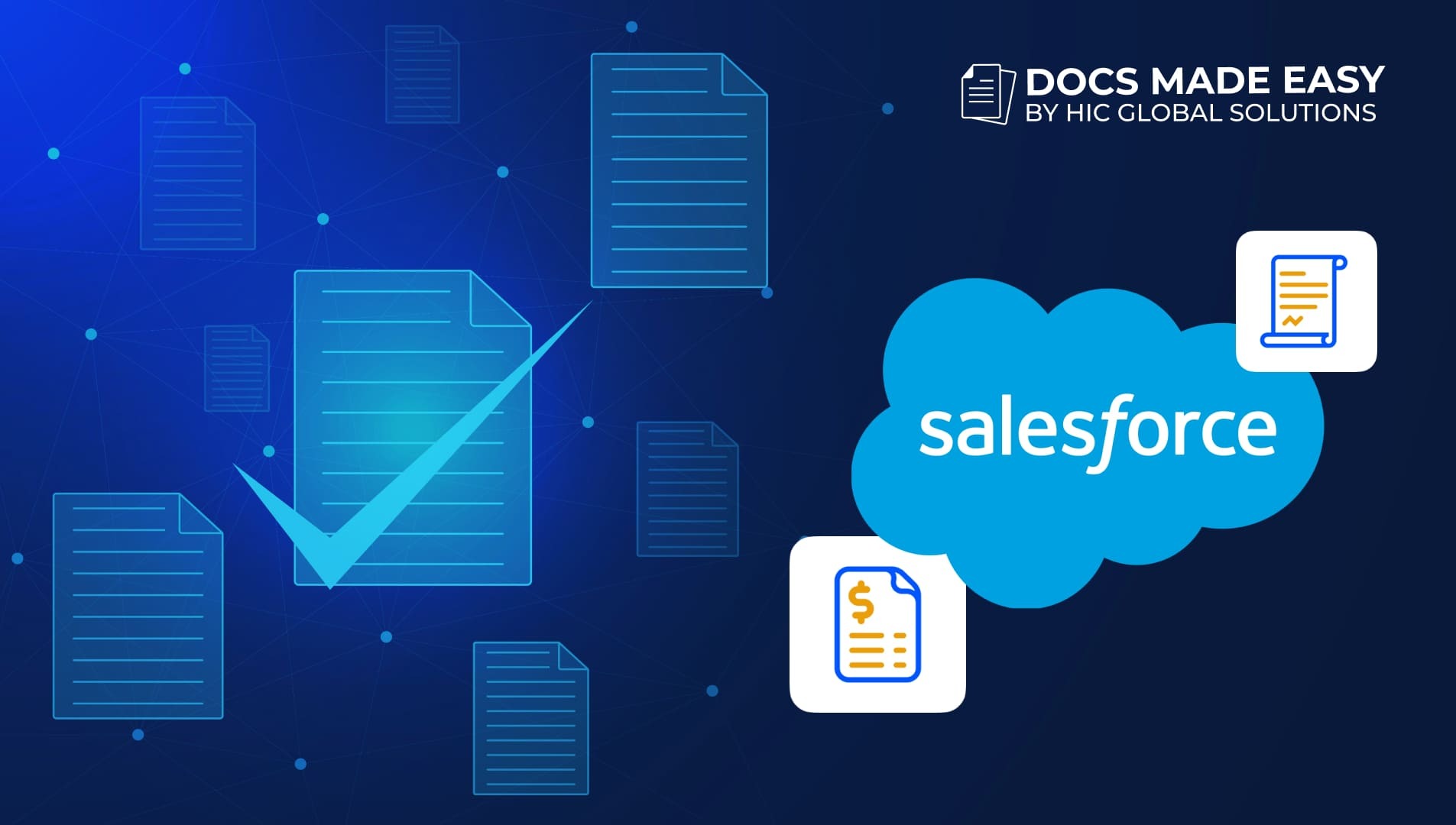
8 Practical Ways to Leverage Salesforce Document Generation Beyond Quotes & Contracts
